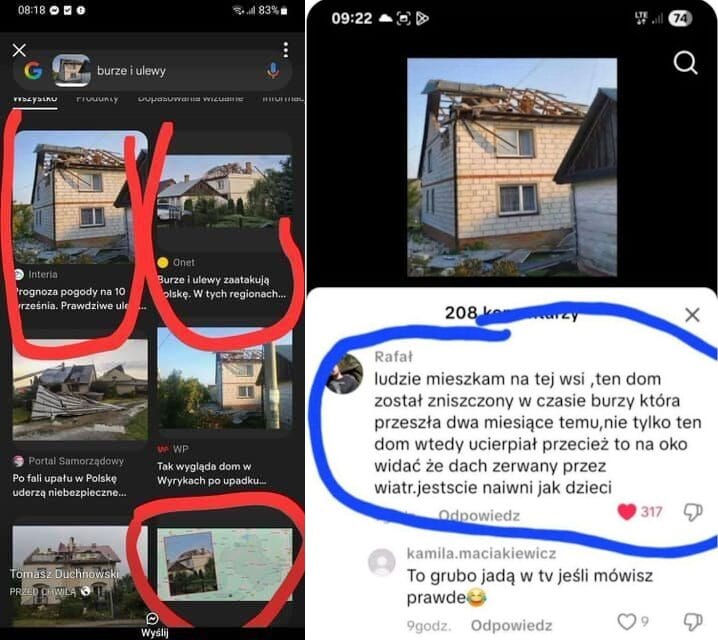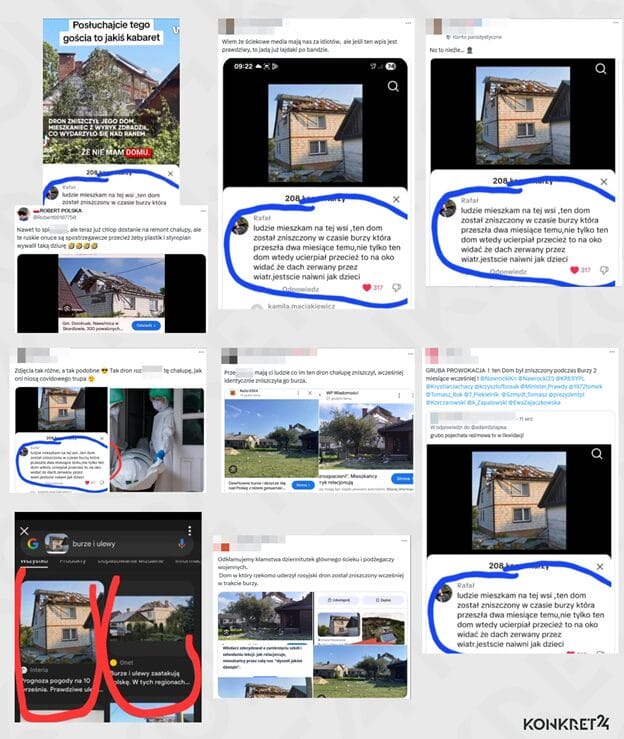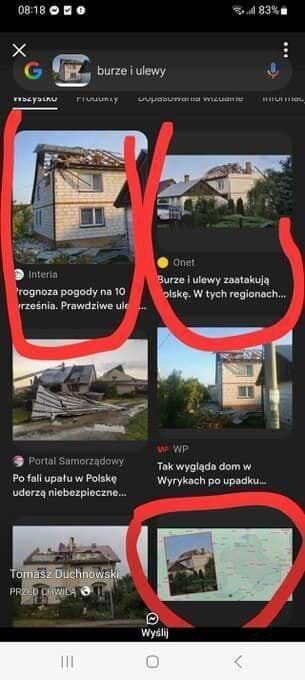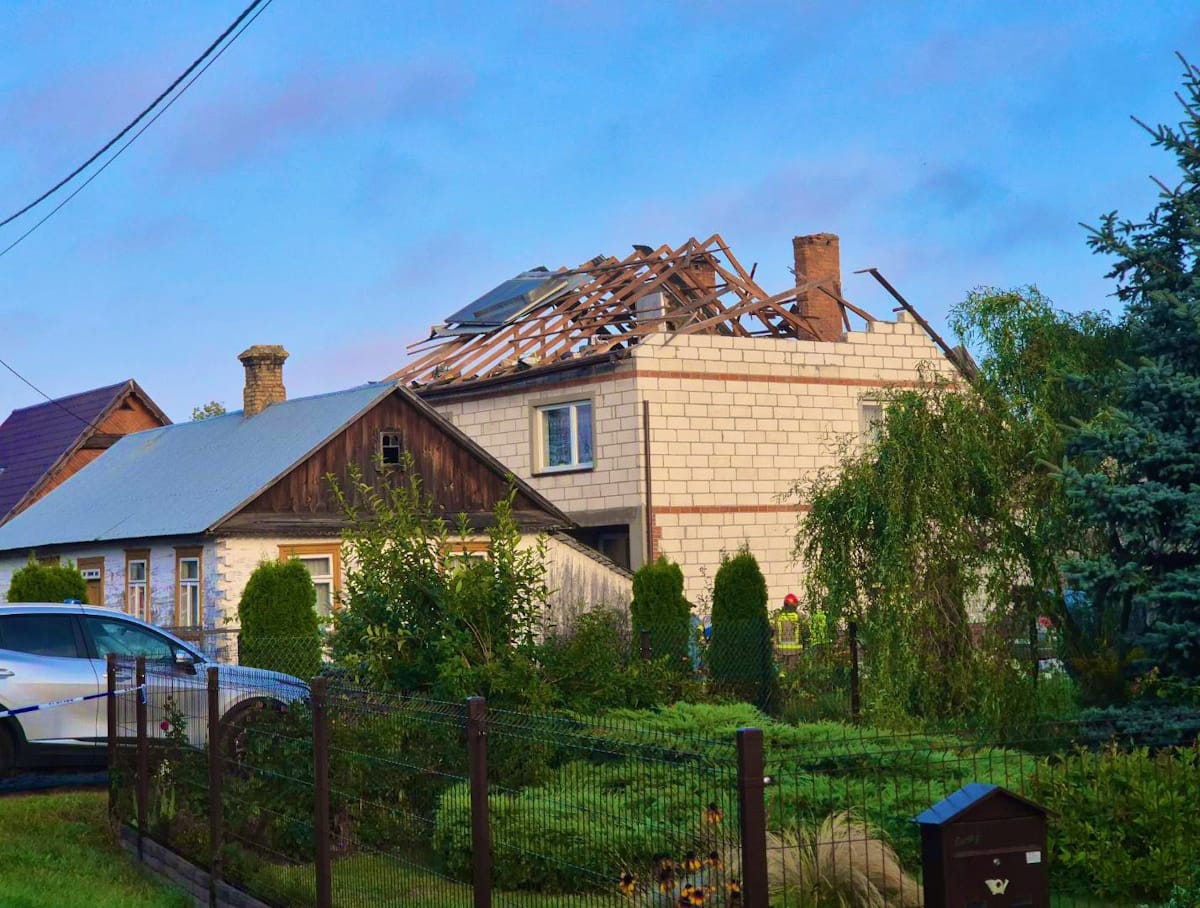In September 2025, news spread on the RuNet that the house, which Polish authorities said was partially destroyed as a result of the fight against drones flying into the country, was in fact damaged due to strong winds. We have verified the veracity of such statements.
On the night of September 9-10, Polish authorities reportedthat several Russian drones flew into the country, participating in the attack on Ukraine. Casualties among the population were avoided, but a residential building was partially destroyed near the country's border. Soon, posts appeared on pro-Kremlin Telegram channels stating that, in fact, photographs of the damaged structure were taken two months earlier, when a storm was raging in the area. As proof, the bloggers cited screenshots of Google search results, where photographs of the house from different angles illustrated meteorological forecasts, and a comment from a local resident confirming this version of events.
On Telegram this news was published by such channels as “Propagandist's Notebook"(203,000 views at the time of writing this analysis), "Two majors"(195,000), "Evil proof"(184,000), Vobla (108,000), "Ukraine.ru» (101,000), etc.

By data Polish authorities, on the night of September 9-10, 19 drones invaded the country's airspace. It was clarified that, according to preliminary data, these were Russian drones that took part in a night attack on targets in Ukraine. The next morning, Prime Minister Donald Tusk said that three or four drones had been shot down and the same number had apparently crashed themselves. At the time of writing this analysis, fragments of the UAV were discovered in 17 localities in five voivodeships.
Concerns about the penetration of Russian drones into Polish airspace expressed more than 40 states, as well as representatives of the EU. 12 September NATO Secretary General Mark Rutte announced on the launch of Operation Eastern Guardian to strengthen the defense of the eastern flank of the alliance. He called the drone invasion of Poland, which became the reason for making such a decision, reckless and unacceptable.
The Ministry of Defense of the Russian Federation, in turn, stated, that during the attack on the territory of Ukraine there were no plans to hit targets in Poland, and suggested holding consultations with Polish colleagues. In a press release, the department emphasized: “The maximum flight range of the Russian UAVs used in the attack, which allegedly crossed the border with Poland, does not exceed 700 km.” This argument used and Russia's permanent representative to the UN Vasily Nebenzya at an emergency meeting of the organization's Security Council on September 12. By that time, the Polish prosecutor's office had already identified in the wreckage of several drones were Gerbera drones (the Russian analogue of the Iranian Shahed-136), which, however, did not carry explosives.
During the drone invasion of Poland suffered residential building in the village of Vyryki-Volya, located near the borders with Ukraine and Belarus. The roof of the building was almost completely destroyed, its debris damaged a car parked nearby. Photos and videos taken at the scene from all possible angles circulated in the Polish and world media. The owner of the house, Tomasz Wesolowski, in an interview with Reuters told, that at 06:30 he was watching news on TV with his wife about the drone invasion, when suddenly he heard the rumble of an airplane and a rumble above, after which a light bulb fell from the ceiling. Running out into the yard, he saw that the roof was destroyed. Tomas's wife Alicia addedthat the bedroom in which the couple lived was under rubble - if everything had happened a little earlier, they could have died. At least three neighbors confirmed Wesolovsky's story. Photographer Tomasz Kawiak, who happened to be nearby at the time of the incident, stated, which saw the drone being attacked by a missile fired from a fighter jet. Regarding whether she got into the drone, Kawiak to the end not sure.
“Verified” did not find any reports in the Polish media that in the last two months in the village of Wyryki Wola in the Lublin Voivodeship there was a strong wind that tore the roofs off the houses. On July 7 a storm was published warning, which mentioned Podkarpackie, as well as parts of the Lublin and Lesser Poland voivodeships, that is, the very southeast of Poland. As a result, there is a storm in the Lublin Voivodeship touched upon Hrubieszów County, where some houses actually lost their roofs. However, Vyryki-Vola is located approximately 65 km north of the border of the povet, and in its vicinity the storm wind that led to destruction occurred for the last time raged June 7, that is, a month earlier.
It is also significant that the house allegedly damaged by the storm in numerous photographs in the press is adjacent to completely intact buildings.

No less suspicious is the fact that two months after the storm, fragments of the building are still scattered on the ground, and a dented car stands nearby. For this reason alone, the version presented in pro-Kremlin Telegram channels seems completely unconvincing.

Moreover, in the first days after the drone invasion, even in the Polish segment of social networks, screenshots of a comment about a storm two months ago, left by a user with the nickname Rafal, were actively distributed. The original source of this comment could not be found, and the same screenshot was distributed everywhere with the same number of likes. Apparently, Rafal and the authors of other similar comments were believed by many Poles: according to the Center for the Analysis of Disinformation of the National Research Institute NASK, just one video in which this theory was presented was watched by 1.7 million people.

However, such statements contradict the fact that fragments of some technical equipment were found at the scene of the incident. Representatives of the prosecutor's office overseeing the investigation of the incident, back on September 11 emphasizedthat the building was hit by an unidentified flying object, not yet identified as a drone or its fragments. Five days later, Rzeczpospolita, one of the largest and most respected Polish newspapers, citing a source reportedthat a missile fired by a fighter jet in an attempt to shoot down a drone fell on the house. This information has not been officially confirmed at the time of writing.
It is noteworthy that a day earlier, on September 15, an eight-minute video appeared in small pro-Kremlin Telegram channels (but did not go viral), in which, against the background of screenshots of articles on Polish sites, a voice-over tells about “media orgasm on demand” and “screaming headlines “Russian drone crashed into a Polish house”.” Although the video makes a relatively correct statement (“The Lublin prosecutor’s office expressed doubt that it was a drone”), the posts themselves say: “The Polish prosecutor’s office found no traces of a drone in the collapsed house.” At the time of publication, this was a clear misrepresentation of the details of the investigation known at that time.
The version about a storm destroying the house outraged Wesolovsky and other residents of Vyryka-Vola. “My son called me and said that people were writing that it was because of the storm. We haven’t had a storm for three months, but they write that it’s after a storm. May God grant them to experience the same thing as us. Let them experience such a “storm”, then they will understand what it’s like,” complained man. Correspondent for Uwaga shared the story of another local resident who stayed up half the night answering comments on the Internet that her neighbors' house was allegedly damaged by a storm two months ago.
Let's look at the screenshots on which this version is based. The main evidence was that in Google, when performing a reverse search on one of the photographs of a dilapidated house, along with the qualifying query “burze i ulewy” (“thunderstorms and downpours”), the results included several articles about the weather, illustrated by this or similar photographs.

In the upper right corner of the viral screenshot is a link to article, published on September 8 in Onet under the title “Thunderstorms and downpours will hit Poland...”. The title was probably changed already on the day of publication, but at the time of writing the analysis it still remained in Google search results in its original form.

This article does not and, judging by the saved copies, did not contain photographs of the dilapidated house.

At the same time, in another article The same publication, dedicated directly to the incident in Vyryki, actually has a photograph from the screenshot. Why Google used exactly this combination of link and image in a reverse image search for the query “thunderstorms and downpours” is not entirely clear. For example, confusion could arise due to the fact that at the time of the request, an article about a destroyed house was included in the “Most Popular” section, which is located to the right of the main material.

The situation is similar with the article of the Polish portal Interia in the upper left corner of the viral screenshot. Search according to the text shown there leads to weather forecast for September 10, published on this site in the Pogoda section. As an illustration, another photograph was used (and, judging by copies in the Internet archives, was originally used).

The photo, which was included in a viral screenshot along with a fragment of a weather forecast, illustrated news article published on Interia a day later.
Fact checkers from the Polish project Demagog found that similar inconsistencies between the title and illustration in Google results were observed also in the case of materials published by Eska.pl. Krzysztof Głowiński, a spokesman for the portal's owner ZPR Media Group, told our colleagues: “The problem of image-to-text misattribution occurs exclusively in the Google search engine, where the algorithm incorrectly assigns a photo to an article and therefore incorrectly displays the text in search results. <…> Misattribution most often occurs because the search engine algorithm relies on a complex set of signals to interpret and select the most representative image, which are not always clear-cut. These include context, file name, image alt text, and image quality and size. Sometimes this results in the search engine assigning [the title in the SERP] an image from an entirely different article that is currently linked to on the page, such as in the “Other”, “Featured” or “See Also” section.”
According to Google's Fact Check Tools, the image most often used to illustrate posts about bad weather from two months ago first appeared online on September 10, when drones invaded Polish airspace.

Analysis of publications using the same service shows that first (With comment Rafal) and second (with Google search results) screenshots began to spread virally on Polish Segment X and Facebook on September 11 between 11:00 and 12:00 Moscow time. Images active published users who have been for years promote ultra-conservative, pro-Russian and/or anti-Ukrainian narratives, and earlier that morning some of them had already exhibited other similar photos. Only in the evening two screenshots made it into the Russian-language segment of Telegram - the earliest such post, discovered by “Verified”, appeared in the channel “Freshness» at 20:22 Moscow time. This channel has already been featured in analyzes “Verified” as a source of misinformation.
Thus, the claim that the house in the Polish village of Wyryki Wola was allegedly damaged not during the Russian drone invasion in September, but due to a storm two months earlier, is not true. This is refuted by numerous testimonies from residents, journalists’ reports and the chronology of publications in local media. The screenshots used as evidence are based on a comment from an unknown Internet user, as well as incorrect results from a reverse image search on Google.
Cover photo: Mirosław Torbicz / Facebook
Read on topic:
- Demagog. Dom w Wyrykach zniszczony przez burzę, a nie drona? Sprawdzamy
- Is it true that such an announcement about additional inspection for Ukrainians appeared on the Polish border?
- Is it true that a Polish TV channel during a weather forecast showed a map of Poland, which includes the territories of Western Ukraine?
If you find a spelling or grammatical error, please let us know by highlighting the error text and clicking Ctrl+Enter.






